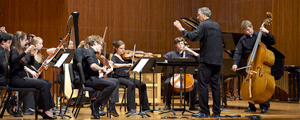by Timothy Robson

Before the program, Timothy Weiss spoke briefly about each of the pieces, in addition to the printed notes in the program booklet. The two sets of notes were complementary. The printed notes were more historical, while Weiss’s comments described the music itself.
Pierre Boulez’s Dérive I (1984) is scored for six players, violin (Yuri Popowycz), cello (Aaron Wolff), flute (Hannah Hammel), clarinet (Jesse McCandless), piano (Marika Yasuda) and vibraphone (Benjamin Rempel). The piece shows characteristics typical of the great French composer/conductor’s works: crystalline textures, florid musical lines, and constantly evolving interaction among the players.
There is no discernible meter. Long-held notes are introduced by grace notes, sometimes one, sometimes a series, beginning on the beat. The lines are further decorated with trills and shimmering vibraphone. Winds and strings morph into one another. After considerable development, the texture becomes suddenly quiet, with a low clarinet trill and mysterious chords in the piano. At the end there are long sustained tones, with soft piano filigree, and final soft pulsing notes. Dérive I was performed without conductor, a notable feat for the complexity of the music.
The elements of ritual and theatricality are never far away in the music of Sir Harrison Birtwistle, whose Cortege (2007) was performed on Saturday. There is a strong Cleveland connection to this work — the U.S. premiere was given at the Cleveland Institute of Music in 2008.
Cortege is a re-composition of a 1990 work, Ritual Fragments, written for the London Sinfonietta. As the name “Cortege” implies, it is an austere work in which the fifteen instruments enact a funereal ceremony. The bass drum acts as a sort of musical leader, playing a rhythmic motif from the opening of Mahler’s Fifth Symphony throughout the work.
The ensemble is arrayed in a semicircle. The other players come individually to the center of the semicircle for brief, but elaborate solos. In his commentary, Timothy Weiss compared these solos to “testimony” that might be given at a funeral. Before the end of each solo, the next soloist comes to the center and overlaps the previous player, who then sits in the chair that has just been vacated. Underpinning the solos, the rest of the ensemble performs music derived from the other musical material. The cello, double bass and piano (and bass drum) form a “continuo” grouping underpinning the rest of the ensemble and do not move. The last soloist is the flute, who performs an even more demanding and spectacular solo before moving to a position in front of each of the other players, letting them stand to play one more brief solo.
The performance was emotionally charged, and musically very fine. Each of the soloists performed his or her solos fluently from memory. The performers were Candy Chang (flute), Timothy Daniels (oboe), Jeremy Reynolds (clarinet), Benjamin Roidl-Ward (bassoon), Emily Rapson (horn), Jacob Flaschen (trumpet), Alexander Melzer (bass trumpet), Carson Fratus (bass drum), Yuri Popowycz and Rebecca Telford-Marx (violin), Natalia Badziak (viola), Chava Appiah (cello), Christopher Ammirati (double bass), and Silei Ge (piano).
The third and final work on this hour-long program was the two-movement Concerto for Cello and 10 Players (1980) by American Richard Wernick with Oberlin cello professor Darrett Adkins as soloist. Timothy Weiss conducted. Two quartets of players were situated stage left and stage right. At center stage were the solo cello, harp and percussion. Percussionist Hunter Brown was the busiest man of the afternoon, racing among the many instruments he was required to play. Other new faces on the stage included bass clarinetist Alejandro Dergai, trombonist Daniel Murphy, and harpist Caitlin Mehrtens.
The first movement, “Entrada,” was highly chromatic, rhythmically spiky, and complex, although there were several more sustained and lyrical passages. Adkins had many notes to play, but the scoring of the concerto was such that much of the solo cello part was subsumed into the texture of the ensemble. After all of the musical activity of the movement, it ends on a single unison note.
The second movement, “Passacaglia” was more interesting, beginning with the quiet, sparkling harp and vibraphone playing the theme, which, true to the passacaglia form, is developed in a set of elaborate variations. At the soloist’s first entrance, the cello plays the theme pizzicato against a sustained ensemble texture. The music is developed through a gradual crescendo to a new, faster, jittery tempo. A lengthy virtuosic cadenza follows, ending with pulsing notes and a return of the harp and vibraphone combination heard at the beginning of the movement. The cello takes over the passacaglia theme as a long, lyrical line.
As the piece winds down, there was a moment of exquisite beauty between the bassoon and harp. After all the complexity, the concerto ended quietly and serenely on the most fundamental of musical intervals, the open fifth. The Oberlin Contemporary Ensemble is scheduled to make a commercial recording of the Wernick concerto. If this performance was any prediction, it should be outstanding.
Published on ClevelandClassical.com December 15, 2014.
Click here for a printable copy of this article



